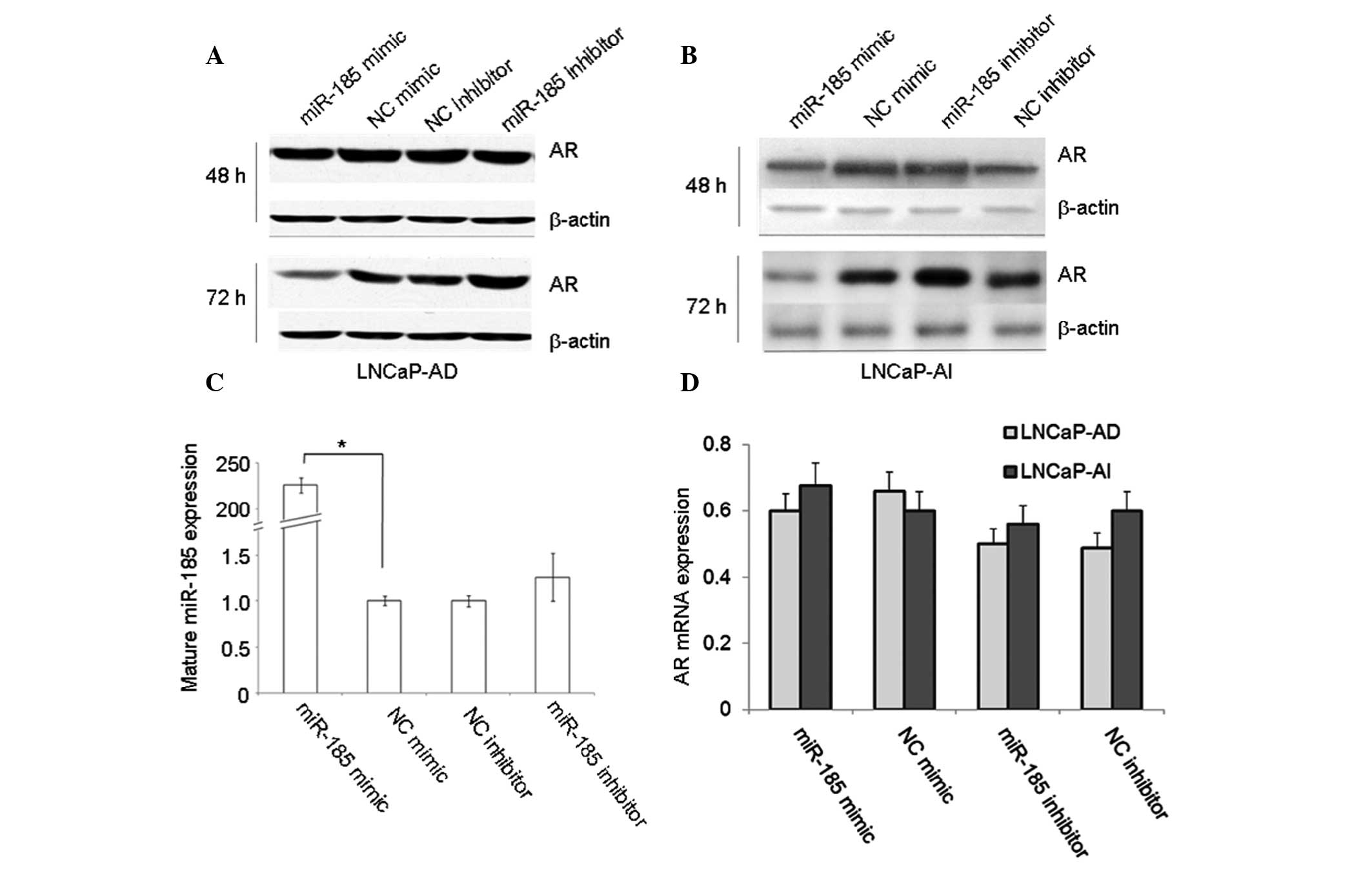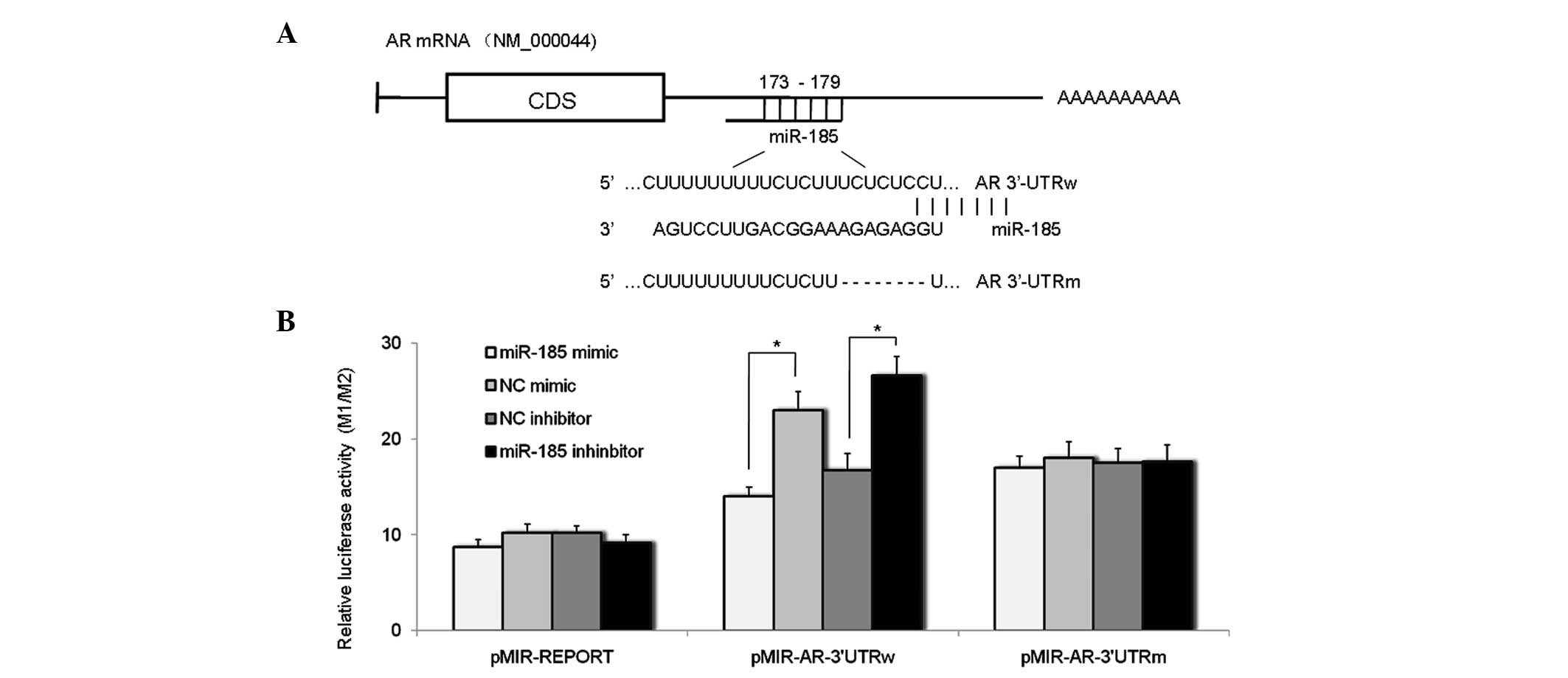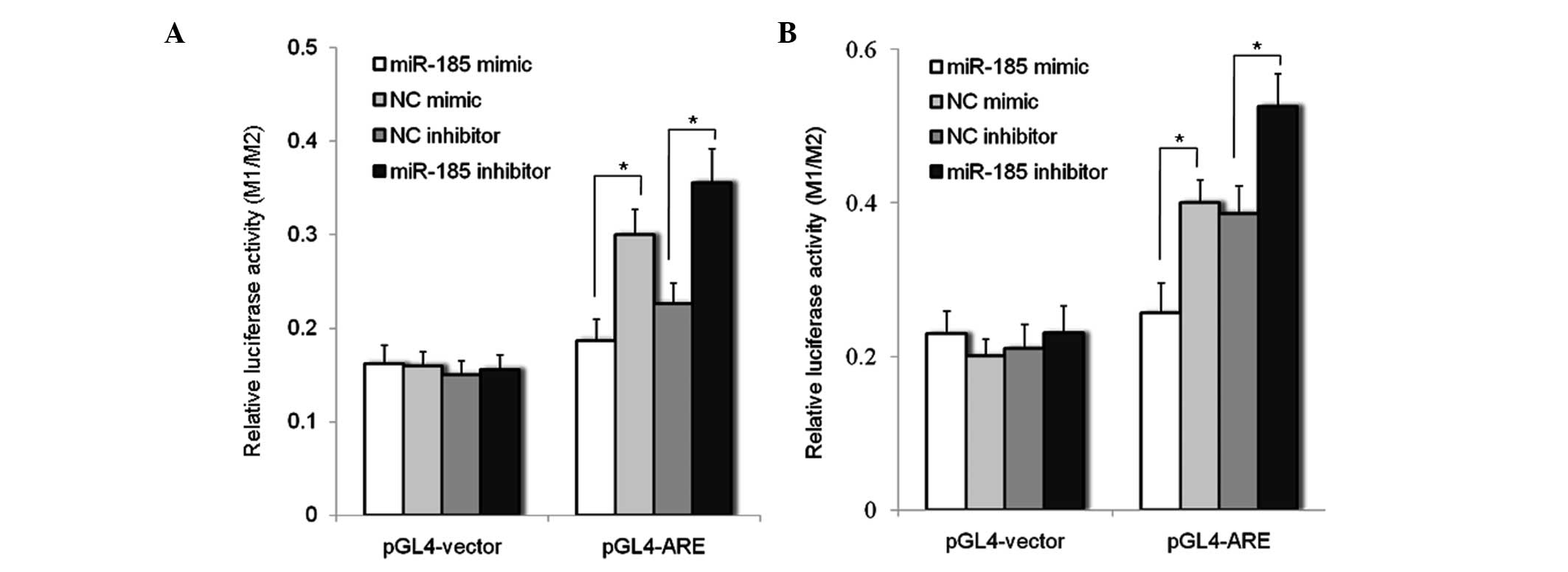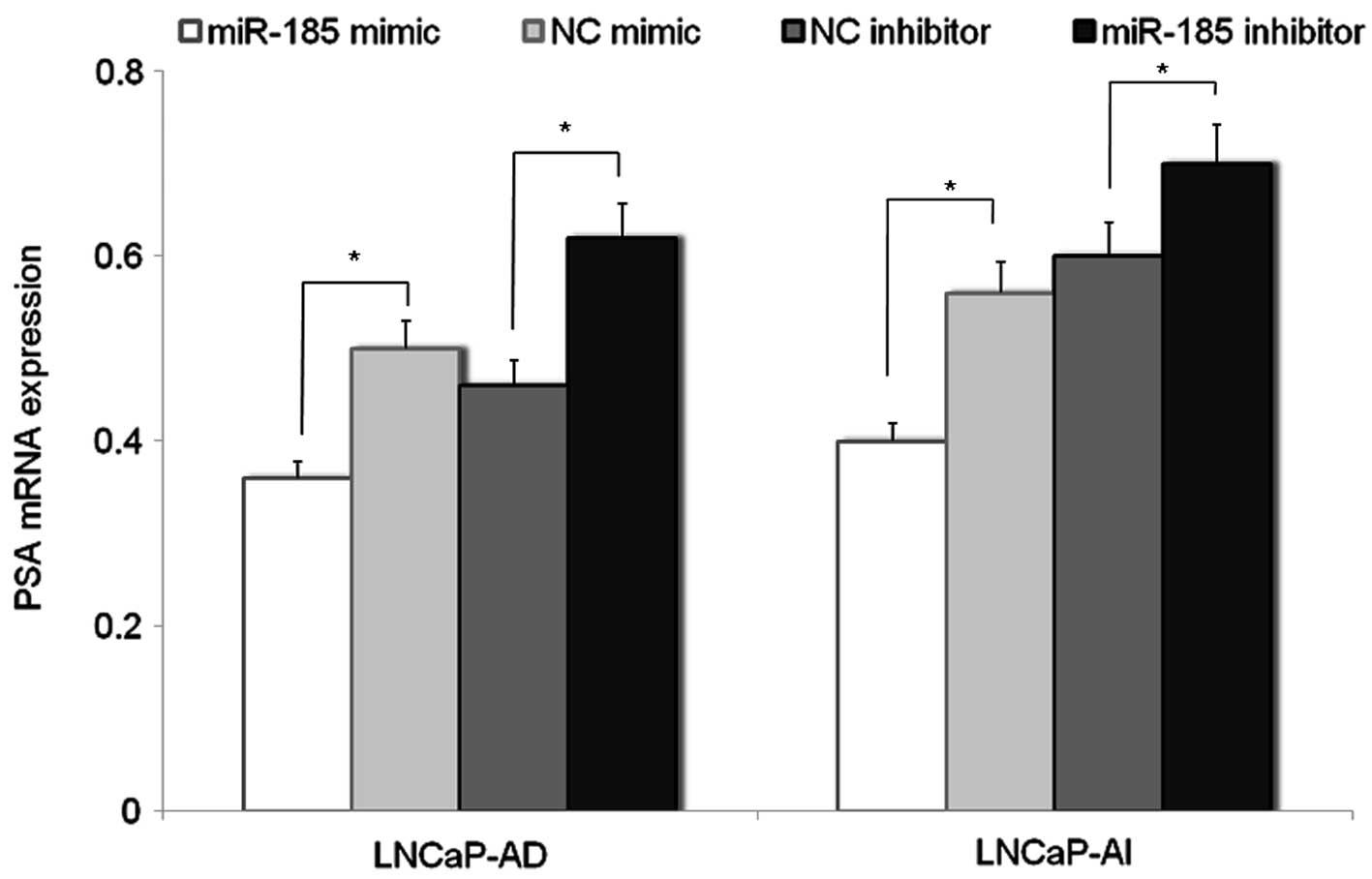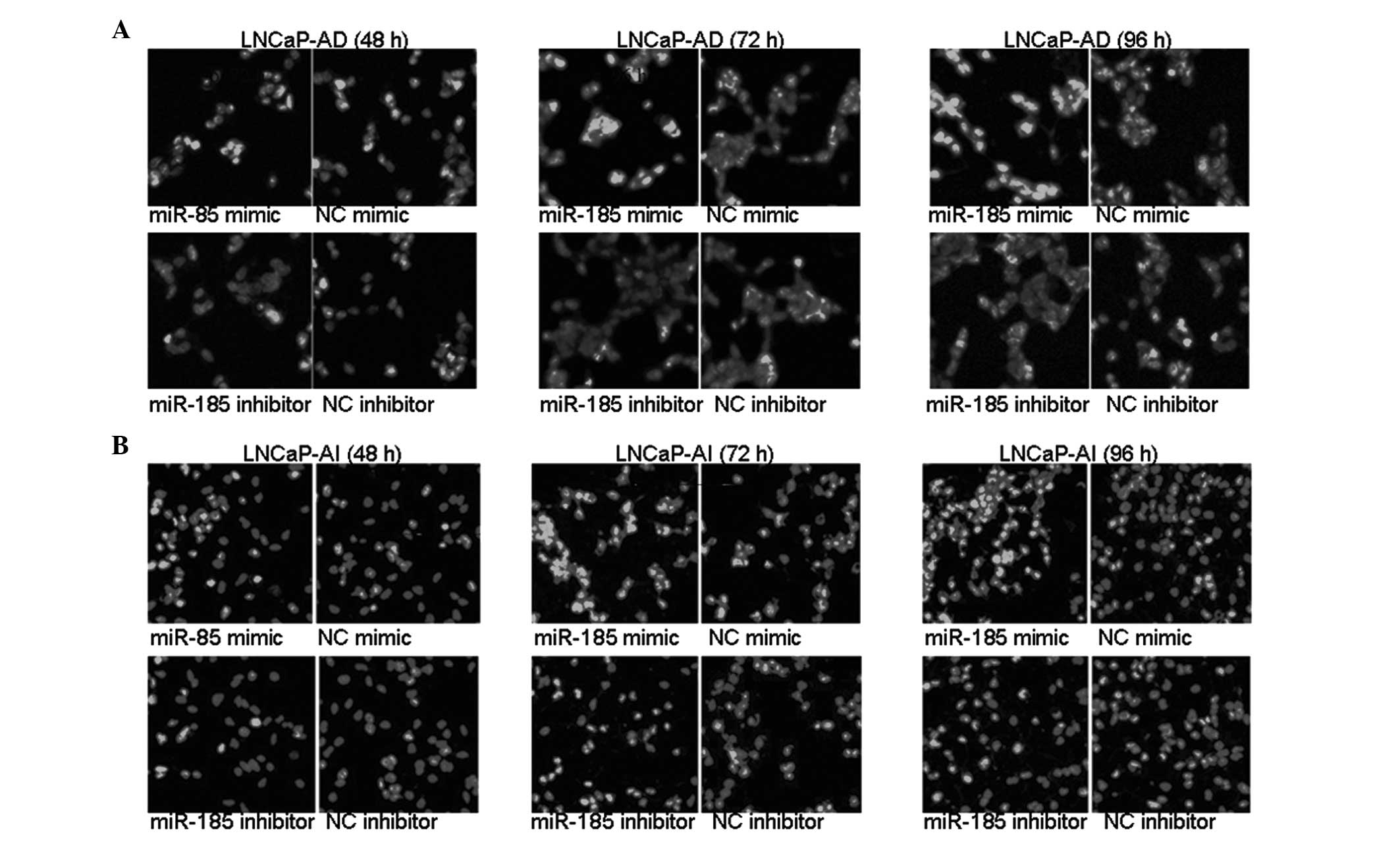MicroRNA-185 downregulates androgen receptor expression in the LNCaP prostate carcinoma cell line
- Authors:
- Published online on: February 11, 2015 https://doi.org/10.3892/mmr.2015.3332
- Pages: 4625-4632
Abstract
Introduction
Prostate cancer (PCa) is the second most common cause of cancer-associated mortality, and the most frequently diagnosed malignancy in males in the USA (1,2). Androgen receptors (AR) have the most significant functions in PCa, in disease initiation and progression (3,4). Targeting the expression of AR and inhibiting AR activity are important in androgen-dependent and androgen-independent diseases. Initially, AR is expressed by the PCa cells, which are dependent on androgens to facilitate growth (5). Common treatments involving androgen ablation have been demonstrated to temporarily alleviate the disease, however, they lead to the recurrence of highly aggressive and androgen-independent types of metastatic cancer (6,7). Previous evidence has suggested that the progression of PCa to the androgen-independent stage does not involve the loss of AR, but is induced by the restoration of AR signaling in the PCa cells (6). During the transformation from the androgen-dependent stage to the androgen-independent stage, PCa cells develop several mechanisms to facilitate the activation of AR in the androgen-depleted environment, including amplification or mutation of the AR gene, overexpression of AR co-activators and the ligand-independent activation of AR (7–9). As the development of PCa progresses, AR activity may evade regulation by ligand binding, resulting in tumor overgrowth (7). Following the activation of molecular pathways to restore AR signaling by PCa cells during the androgen-independent phase, no single therapeutic agent is able to eliminate PCa, resulting in poor patient prognosis (10). As AR is important in the development and progression of PCa, a strategy to downregulate the expression of AR and the inhibition of AR activity, in combination with anti-androgen therapy may prevent or delay the development of androgen-independent PCa (11–16).
Micro (mi)RNAs are short, endogenous, non-coding RNA molecules, which bind to the 3′-untranslated regions (UTRs) of target mRNAs, resulting in translational repression or message degradation (17–18). miRNAs are important in physiological cellular processes, including differentiation, proliferation and apoptosis (19–22), and have also been implicated in types of cancer (23,24). Several studies have demonstrated that miRNA (miR)-185 is able to suppress tumor growth and progression in non-small cell lung cancer (25), ovarian, pediatric renal and breast cancer cell lines (26,28), and it has been suggested that miR-185 may be important in cell proliferation.
The present study aimed to investigate whether miR-185 affected the expression of AR, cell proliferation or apoptosis of PCa LNCaP cells. The results may provide evidence for the utilization of miRNAs as novel therapeutics to target AR in PCa.
Materials and methods
Cell culture
The human LNCaP-AD (androgen-dependent LNCaP) PCa cell line was obtained from American Type Culture Collection (ATCC; Manassas, VA, USA) and cultured in RPMI-1640 medium (HyClone, GE Healthcare Life Sciences, Little Chalfont, UK) supplemented with 10% charcoal-treated fetal bovine serum (FBS; Sigma-Aldrich, St. Louis, MO, USA), 2.05 mM L-glutamine, 100 U/ml penicillin, 100 μg/ml streptomycin and 10−8 mol/l R1881 (Sigma-Aldrich).
Androgen-independent LNCaP cells (LNCaP-AI) were generated from LNCaP-AD cells under androgen-depleted conditions. LNCAP-AI cells were produced from LNCaP-AD cells following continuous culture with phenol red-free RPMI-1640 medium (HyClone, GE Healthcare Life Sciences, Logan, UT, USA) supplemented with 10% charcoal-stripped fetal bovine serum (Serana, Bunbury, Australia) for 50 passages. The human PC-3 PCa cell line was obtained from ATCC and cultured in RPMI-1640 medium (HyClone) supplemented with 10% FBS (TBD Science, Tianjin, China), 2.05 mM L-glutamine, 100 U/ml penicillin and 100 μg/ml streptomycin. All the cell lines were maintained at 37°C in a humidified atmosphere containing 5% CO2.
Plasmid construction
The wild-type (WT) 3′UTR of the human AR gene was amplified from human AR complementary (c)DNA by polymerase chain reaction (PCR) using a PCR kit purchased from Takara (Dailan, China), and the fragments produced by PCR were cut using MluI and HindIII (Thermo Fisher Scientific, Waltham, MA, USA) before being cloned into the 3′ end of the luciferase (LUC) reporter gene in a pMIR-REPORT Luciferase vector (Ambion Life Technologies, Carlsbad, CA, USA), and named pMIR-AR-3′UTRw. The PCR primers used to amplify the AR-3′UTR were as follows: AR forward (ARF), 5′-CGACGCGTAGTCAAGCCCATCTAT-3′ and reverse (ARR), 5′-CCAAGCTTGTTTGCTTGTTTTTGTT-3′ (BGI, Shenzhen, China). The PCR cycling conditions were as follows: Initial denaturation at 94°C for 45 sec; 30 cycles of 60°C for 30 sec and 72°C for 1 min and final elongation at 72°C for 5 min.
Deletion mutagenesis of the putative target site for miR-185 in the WT-3′UTR of AR was performed using a two-step PCR method. Using pMIR-AR-3′UTRw as the template, a 5′ flanking fragment of the deletion region was PCR amplified with the primers, ARF and deletion reverse (5′-GAAAAAGAAAAAAAGCCCAGCAAAT-3′), and the 3′ lanking fragment was PCR amplified with the primers, ARR and deletion forward (5′-GCTTTTTTTCTTTTTCTTCTTCCCTC-3′) (BGI). The two fragments were linked to the primers by ligation with PCR. The ligated fragments were cloned into the MluI and HindIII sites of pMIR-REPORT Luciferase, and the plasmid was named pMIR-AR-3′UTRm.
For construction of the pGL4-androgen response element (ARE) reporter plasmid, oligonucleotides of the putative ARE were synthesized. The double-stranded ARE was generated by annealing equal quantities of forward 5′-TCGAGTGGAGGAACATATTGT ATTTATTTGGAGGAACATATTGTATTTATTA-3′ and reverse 5′-AGCTTAATAAATACAATATGTTCCTCCA AATAAATACAATATGTTCCTCCAC-3′ oligonucleotides at 95°C for 10 min, followed by cooling to room temperature. Subsequently, the double-stranded ARE was inserted upstream of the TATA box in the pGL4.23 [luc2/minp] vector (Promega Corporation, Madison, WI, USA) to generate the recombinant plasmid, ARE-TATA box-luciferase reporter, which was named pGL4-ARE. Nucleotide sequences of all the constructs were confirmed by DNA sequencing.
Cell transfection
The LNCaP cells were transfected with the miR-185 mimic (160 nM), normal control (NC) mimic (160 nM), miR-185 inhibitor (160 nM) or NC inhibitor (160 nM) at 40% confluency using siPORT™ NeoFX™ transfection agent (Ambion Life Technologies) at room temperature, according to the manufacturer’s instructions. The pMIR-AR-3′UTRw, pMIR-AR-3′UTRm and pGL4-ARE plasmids were transfected into the cells at 90% confluency using FuGENE HD (Roche Diagnostics, Basel, Switzerland) at room temperature, according to the manufacturer’s instructions.
Cell viability assay
The LNCaP-AD, LNCaP-AI and PC-3 cells were seeded into 96-well plates at 40% confluency and transfected with either the miR-185 mimic, miR-185 inhibitor, NC mimic or the NC inhibitor using the siPORT™ NeoFX™ transfection agent at room temperature. The cell viabilities were then determined 24, 48, 72 and 96 h after transfection using an MTT assay (Sangon Biotech Co., Ltd, Shanghai, China), according to the manufacturer’s instructions. Three independent experiments were performed.
Nuclear staining with Hoechst 33342
The LNCaP-AD or LNCaP-AI cells were seeded into 24-well plates at 40% confluency and transfected with either miR-185 mimic, miR-185 inhibitor, NC mimic or NC inhibitor using siPORT™ NeoFX™ transfection agent at room temperature. Apoptotic cells were detected 48, 72 and 96 h after transfection using Hoechest 33258 (Beyotime Institute of Biotechnology, Shanghai, China), according to the manufacturer’s instructions. Images of the stained cells were captured under a fluorescent microscope (Eclipse TE2000-U; Nikon Corp., Tokyo, Japan) at 350 nm excitation and 460 nm emission.
Reverse transcription quantitative polymerase chain reaction (RT-qPCR)
The LNCaP-AD or LNCaP-AI cells were seeded into 6-well plates and transfected with either the miR-185 mimic, miR-185 inhibitor, NC mimic or NC inhibitor using siPORT™ NeoFX™ transfection agent. The total RNA was extracted 72 h after transfection using TRIzol reagent (Invitrogen Life Technologies, Carlsbad, CA, USA). First strand cDNA was synthesized from 10 ng total RNA using gene specific primers. RT-qPCR was performed using MonsterScript™ Reverse Transcriptase (Epicentre, Illumina, Inc., Madison, WI, USA) and SYBR® Green I nucleic acid gel stain (Molecular Probes Life Technologies, Carlsbad, CA, USA).
The primers used were as follows: miR-185, forward 5′- GGTGGAGAGAAAGGCAGT-3′ and reverse 5′-CAGTGCGTGTCGTGGAG-3′; U6 snRNA, forward 5′-GCTTCGGCAGCACATATACTAAAAT-3′ and reverse 5′-CGCTTCACGAATTTGCGTGTCAT-3′. U6 snRNA was used as a control gene for normalization. The relative quantity of miR-185 was determined using the 2−ΔΔCt method (29).
The primers used for AR were: For ward 5′-CTTCCCTCCCT ATCTAACCCTC-3′ and reverse 5′-TCTAAAC TTCCCGTGGCATAA-3′; for PSA were: Forward 5′-AGGTGTGCTGACTATGTGGTGAC-3′ and reverse 5′-GGTTGAGGTTCCAGGTGCTT-3′; and for GAPDH were: Forward 5′-GGGAAACTGTGGCGTGAT-3′ and reverse 5′-GAGTGGGTGTCGCTGTTGA-3′. PCR conditions for AR were: initial denaturation at 95°C for 5 min; 35 cycles of 95°C for 10 sec, 59°C for 15 sec, 72°C for 20 sec and 82°C (fluorescence collection) for 5 sec. PCR conditions for PSA and GAPDH were: initial denaturation at 95°C for 5 min; 35 cycles of 95°C for 10 sec, 59°C for 15 sec, 72°C for 20 sec and 80°C (fluorescence collection) for 15 sec. GAPDH was used as a control for normalization, and the data were analyzed with Rotor-Gene Real-Time Analysis software 6.0 (Corbett Research, Mortlake, Australia) according to the standard curve.
Dual-luciferase assay
The LNCaP-AD cells were seeded in 24-well plates and transfected for 24 h with either the miR-185 mimic, miR-185 inhibitor, NC mimic or NC inhibitor using siPORT™ NeoFX™ transfection agent. Subsequently, the LNCaP-AD cells were co-transfected with either pMIR-AR-3′UTRw (0.3 μg), pMIR-AR-3′UTRm (0.3 μg) or pMIR-REPORT (0.3 μg), or co-transfected with pGL4-ARE (0.3 μg) or pGL4.23[luc2/minp] using FuGENE HD transfection reagent (Roche Diagnostics, Mannheim, Germany) for 48 h. The activities of firefly (M1) and Renilla (M2) luciferase were measured using a Dual Luciferase Assay system (Promega Corporation), according to the manufacturer’s instructions. The transfection efficiency was normalized to the pRL-TK control vector (0.04 μg; Promega Corporation). Three independent experiments were performed in duplicates.
Western blot analysis
The LNCaP-AD or LNCaP-AI cells were seeded into 6-well plates and transfected with either the miR-185 mimic, miR-185 inhibitor, NC mimic or NC inhibitor using siPORT™ NeoFX™ transfection agent. The cells were harvested 48 and 72 h after transfection for protein extraction. The protein (20 μg) was resolved on an 10% SDS-PAGE gel and electrotransferred onto nitrocellulose membranes (Bio-Rad Laboratories, Inc., Hercules, CA, USA) using a DYCZ-40D (Beijing Liuyi Instrument Factory, Beijing, China). Following blocking with 5% milk in Tris-buffered saline with 0.05% Tween-20 (TBST) buffer (Sangon Biotech Co., Ltd) and washing with TBST buffer, the membrane was incubated with mouse monoclonal anti-human AR (1:1,000; BD Biosciences, Franklin Lakes, NJ, USA) or mouse anti-β-actin (1:1,000; Santa Cruz Biotechnology, Inc., Dallas, TX, USA) at 4°C for 12 h, followed by incubation with horseradish peroxidase-labeled goat anti-mouse polyclonal secondary antibody (1:2,000; Zhongshan Golden Bridge Biological Technology, Beijing, China) for 1 h at room temperature. The immunoreactive bands were visualized by enhanced chemiluminescence (Santa Cruz Biotechnology, Inc.). The protein expression levels of AR in each sample were determined by normalizing AR band intensity to that of β-actin.
Sequence Analysis
TargetScan predicts the biological targets of miRNAs. This is via searching a database for conserved 8mer and 7mer sites, which match seed regions of the miRNA being screened, nonconserved sites are also predicted. In addition sites with mismatches in the seed region that are compensated by conserved 3′ pairing are also identified. In mammals, the predictions are ranked based on the predicted targeting efficacy as calculated using context+ scores of the sites. The predictions are also ranked by their probability of conserved targeting. Conserved targeting has also been detected within open reading frames.
Results
miR-185 downregulates protein expression levels of AR in LNCaP cells
To investigate the potential effects of miR-185 on the regulation of AR expression, LNCaP-AD and LNCaP-AI cells were transfected with an miR-185 mimic or inhibitor for 48 and 72 h, and the expression levels of AR were detected using western blot and qPCR analyses. The results indicated that transfection with the miR-185 mimic markedly reduced the protein levels of AR, while transfection with the miR-185 inhibitor increased the protein levels of AR in the LNCaP-AD (Fig. 1A) and LNCaP-AI (Fig. 1B) cells.
The mature miR-185 levels in the miR-185-transfected LNCaP cells were measured by qPCR. The mature levels of miR-185 in the LNCaP cells transfected with the miR-185 mimic were significantly higher compared with those in the NC mimic-treated cells (Fig. 1C), which indicated that the synthetic miR-185 mimic was effectively transfected and matured in the LNCaP cells. However, differences in the mRNA expression levels of AR were not detected in all types of transfected LNCaP cells (Fig. 1D). The results demonstrated that miR-185 reduced the protein levels of AR by inducing translational repression, but not AR mRNA degradation.
miR-185 interacts with the putative target site in the AR-3′UTR
Sequence analysis, using the TargetScan tool (version 5.2; http://www.targetscan.org/vert_50/), indicated that a putative binding site for miR-185 was located at 173–179 bp of the AR-3′ UTR. To assess whether miR-185 interacted with this predicted binding site in the AR-3′ UTR to reduce the expression of AR, wild-type 3′UTR (3′UTRw) and the 3′UTR of the AR gene, containing deletion mutations (3′UTRm), were cloned and inserted downstream of the luciferase gene in a reporter plasmid (pMIR-REPORT Luciferase), and named pMIR-AR-3′UTRw and pMIR-AR-3′UTRm. Each of these constructs were cotransfected into the LNCaP-AD cells with either the miR-185 mimic, miR-185 inhibitor, NC mimic or NC inhibitor. Luciferase activity was measured 48 h after transfection. The results (Fig. 2) indicated that transfection with the miR-185 mimic markedly reduced luciferase activity, while the miR-185 inhibitor enhanced luciferase activity of the pMIR-AR-3′UTRw. However, neither the miR-185 mimic nor miR-185 inhibitor altered the luciferase activities of the pMIR-AR-3′UTRm or pMIR-Report plasmids. Therefore, these data indicated that the predicted target site in the AR 3′UTR was a specific functional binding site for miR-185, and that AR was a direct target of miR-185.
miR-185 impairs the interaction of AR with ARE
AR is a ligand-activated transcription factor, which induces the transcription of genes exhibiting ARE in their regulatory regions (3). In order to examine whether the downregulation of AR by miR-185 impaired the interaction between AR and ARE, an ARE sequence was synthesized and inserted upstream of the TATA box in pGL4.23 [luc2/minp] plasmids, named pGL4-ARE. pGL4-ARE was cotransfected into the LNCaP-AD and LNCaP-AI cells with either the miR-185 mimic or inhibitor. Luciferase activity was measured 72 h after transfection. The results indicated that transfection with the miR-185 mimic reduced luciferase activity, while miR-185 inhibitor increased the luciferase activity of pGL4-ARE in LNCaP-AD (Fig. 3A) and LNCaP-AI (Fig. 3B) cells, demonstrating that downregulation of AR by miR-185 may impair the interaction between AR and ARE.
miR-185 down-regulates the expression of AR target gene prostate specific antigen (PSA)
PSA is a prostate specific gene, regulated by AR. In the present study, the effects of AR downregulation by miR-185 on the expression of PSA mRNA in LNCaP cells was evaluated. The results of PCR analysis indicated that the expression of PSA mRNA in LNCaP-AD and LNCaP-AI cells transfected with miR-185 mimic was reduced compared with that in cells transfected with the NC mimic, while the mRNA expression of PSA in the miR-185 inhibitor-transfected LNCaP cells was increased compared with the NC inhibitor-transfected cells (Fig. 4).
miR-185 inhibits the proliferation of LNCaP cells
To investigate the potential of miR-185 to inhibit the growth of LNCaP cells by downregulation the expression of AR, the LNCaP-AD, LNCaP-AI and PC-3 cells were transfected with either the miR-185 mimic or inhibitor, and the numbers of viable cells were measured 24, 48, 72 and 96 h after transfection using an MTT assay. The results indicated that the miR-185 mimic reduced, while the miR-185 inhibitor increased the numbers of viable LNCaP-AD (Fig. 5A) and LNCaP-AI (Fig. 5B) cells. The same transfection procedure was performed in PC-3 cells, not expressing AR, in which the miR-185 mimic or inhibitor had no significant effects on cell proliferation (Fig. 5C). These data demonstrated that the effect of miR-185 on cell growth was associated with downregulation of AR in the LNCaP cells.
miR-185 induces the apoptosis of LNCaP cells
The LNCaP-AD and LNCaP-AI cells were transfected with either miR-185 mimic or inhibitor for 48, 72 and 96 h. Apoptosis was assessed using Hoechest 33258 staining. As shown in Fig. 6, following transfection with miR-185 mimic, significantly more LNCaP-AD and LNCaP-AI cells exhibited chromatin condensation and marginalization compared with the NC mimic-transfected cells. By contrast, transfection with the miR-185 inhibitor resulted in a decreased number of LNCaP-AD and LNCaP-AI cells with nucleic chromatin condensation compared with the cells transfected with the NC inhibitor. These data demonstrated that the miR-185-mediated downregulation of AR induced apoptosis of the LNCaP cells.
Discussion
In the past few years, numerous studies have demonstrated that miRNAs are important in the developmental process of cancer (30–33). They may function as oncogenes or tumor suppressor genes (34) in tumorigenesis, and regulate multiple cellular processes involved in the progression of cancer. Due to each miRNA regulating numerous potential targets, identification of the true target genes that are involved in cancer cell behaviors is important for understanding the mechanisms underlying the functional contributions of miRNAs in tumor development and progression.
Several studies have demonstrated that miR-185 functions as a tumor suppressor, which is able to suppress tumor growth and progression in non-small lung carcinoma, ovarian, pediatric renal and breast cancer cell lines (25–28). It has also been suggested that miR-185 may be important in cell proliferation (25–28). However, the mechanisms by which miR-185 inhibits cell proliferation in different cancer cells vary. miR-185 suppresses the growth of the human non-small cell lung cancer cell lines and induces cell cycle arrest by suppressing the mRNA expression of cell cycle regulating genes, including CDK6 and AKT1 (25). Additionally, miR-185 suppresses tumor growth and progression by targeting the Six1 oncogene in multiple types of human cancer, including pediatric renal tumors, aggressive ovarian cancer and breast cancer (26). In colorectal cancer cells, miR-185 directly regulates the expression of RhoA and Cdc42 and their associated functions, including proliferation and invasion (35). In contrast to its role in tumor suppression, miR-185 was also demonstrated to induce tumor growth and progression in clear cell renal cell carcinoma (36). The expression of miR-185 was inversely correlated with its putative target PTPN13, which suppressed cell growth and induced apoptosis as a tumor suppressor gene by inhibiting phosphoinositide 3-kinase (PI3K)/AKT signaling (37). These findings suggest that miR-185 may target differing genes in various cell types, which contribute to different biological processes.
The results of the present study confirmed miR-185 as a tumor suppressor gene, which exerted its effect through modulating the expression of AR, inhibiting cell proliferation and enhancing apoptosis of the LNCaP cells. Computational analysis revealed a potential binding site for miR-185 in the 3′UTR of AR. Deletion mutagenesis and a luciferase-based reporter gene assay demonstrated that the predicted miR-185 target sites in the AR 3′UTR were functional. Furthermore, data indicated that miR-185 effectively downregulated the protein expression of AR, impaired the interaction of AR with ARE and downregulated the expression of the AR target gene, PSA.
AR is a ligand-dependent transcription factor belonging to the nuclear hormone receptor superfamily (38). AR functions as a ligand-dependent transcription factor by binding to AREs in the regulatory regions of specific androgen-regulated target genes (39). The development of PCa and growth of prostate tissue depend on androgen signaling via the AR (14,40); therefore, downregulation of the expression levels of AR and androgens is a basic therapeutic strategy in preventing the development of PCa.
Based on the significance of AR for the androgen-dependent and androgen-independent growth of PCa cells (6), understanding the association between miR-185 and AR is important for investigation of prostate carcinogenesis and therapeutics. An increasing number of studies have focused on improving PCa treatment by developing more effective strategies for silencing AR (41–44). A combinatorial approach, involving the simultaneous targeting of multiple pathways, is an accepted approach in the development of PCa therapy and the development of numerous therapeutic options, which can be evaluated in combinatorial therapy settings is being emphasized at present (10). Therefore, the results of the present study, revealing that miR-185 mediated the repression of AR expression and activity, are of significance.
In conclusion, the present study demonstrated that miR-185 directly targeted the AR-3′UTR, to inhibit the expression of AR, and acted as a tumor suppressor in the PCa cells. miR-185 is, therefore, a potential negative modulator of AR-mediated signaling with potential for use in PCa therapeutics.
Acknowledgments
This study was supported by grants from the National Natural Science Foundation of China (nos. 81071720 and 81172045), Shandong Provincial Programs for Science and Technology Development (no. 2012GSF11820) and the Foundation for Outstanding Young Scientists in Shandong Province (no. 2006BS03066).
References
|
Jemal A, Siegel R, Xu J and Ward E: Cancer statistics, 2010. CA Cancer J Clin. 60:277–300. 2010. View Article : Google Scholar : PubMed/NCBI | |
|
Jemal A, Siegel R, Ward E, Hao Y, Xu J and Thun MJ: Cancer statistics, 2009. CA Cancer J Clin. 59:225–249. 2009. View Article : Google Scholar : PubMed/NCBI | |
|
Dehm SM and Tindall DJ: Androgen receptor structural and functional elements: role and regulation in prostate cancer. Mol Endocrinol. 21:2855–2863. 2007. View Article : Google Scholar : PubMed/NCBI | |
|
Buchanan G, Irvine RA, Coetzee GA and Tilley WD: Contribution of the androgen receptor to prostate cancer predisposition and progression. Cancer Metastasis Rev. 20:207–223. 2001. View Article : Google Scholar | |
|
Agoulnik IU and Weigel NL: Androgen receptor action in hormone-dependent and recurrent prostate cancer. J Cell Biochem. 99:362–372. 2006. View Article : Google Scholar : PubMed/NCBI | |
|
Taplin ME and Balk SP: Androgen receptor: a key molecule in the progression of prostate cancer to hormone independence. J Cell Biochem. 91:483–490. 2004. View Article : Google Scholar : PubMed/NCBI | |
|
Feldman BJ and Feldman D: The development of androgen-independent prostate cancer. Nat Rev Cancer. 1:34–45. 2001. View Article : Google Scholar | |
|
Pienta KJ and Bradley D: Mechanisms underlying the development of androgen-independent prostate cancer. Clin Cancer Res. 12:1665–1671. 2006. View Article : Google Scholar : PubMed/NCBI | |
|
Chen Y, Sawyers CL and Scher HI: Targeting the androgen receptor pathway in prostate cancer. Curr Opin Pharmacol. 8:440–448. 2008. View Article : Google Scholar : PubMed/NCBI | |
|
Knudsen KE and Scher HI: Starving the addiction: new opportunities for durable suppression of AR signaling in prostate cancer. Clin Cancer Res. 15:4792–4798. 2009. View Article : Google Scholar : PubMed/NCBI | |
|
Eder IE, Culig Z, Ramoner R, Thurnher M, Putz T, Nessler-Menardi C, Tiefenthaler M, Bartsch G and Klocker H: Inhibition of LncaP prostate cancer cells by means of androgen receptor antisense oligonucleotides. Cancer Gene Ther. 7:997–1007. 2000. View Article : Google Scholar : PubMed/NCBI | |
|
Zegarra-Moro OL, Schmidt LJ, Huang H and Tindall DJ: Disruption of androgen receptor function inhibits proliferation of androgen-refractory prostate cancer cells. Cancer Res. 62:1008–1013. 2002.PubMed/NCBI | |
|
Wright ME, Tsai MJ and Aebersold R: Androgen receptor represses the neuroendocrine transdifferentiation process in prostate cancer cells. Mol Endocrinol. 17:1726–1737. 2003. View Article : Google Scholar : PubMed/NCBI | |
|
Chen CD, Welsbie DS, Tran C, et al: Molecular determinants of resistance to antiandrogen therapy. Nat Med. 10:33–39. 2004. View Article : Google Scholar : PubMed/NCBI | |
|
Hååg P, Bektic J, Bartsch G, Klocker H and Eder IE: Androgen receptor down regulation by small interference RNA induces cell growth inhibition in androgen sensitive as well as in androgen independent prostate cancer cells. J Steroid Biochem Mol Biol. 96:251–258. 2005. View Article : Google Scholar : PubMed/NCBI | |
|
Compagno D, Merle C, Morin A, Gilbert C, Mathieu JR, Bozec A, Mauduit C, Benahmed M and Cabon F: SIRNA-directed in vivo silencing of androgen receptor inhibits the growth of castration-resistant prostate carcinomas. PLoS One. 2:e10062007. View Article : Google Scholar : PubMed/NCBI | |
|
Di Giacomo G, Koss M, Capellini TD, Brendolan A, Pöpperl H and Selleri L: Spatio-temporal expression of Pbx3 during mouse organogenesis. Gene Expr Patterns. 6:747–757. 2006. View Article : Google Scholar : PubMed/NCBI | |
|
Lichtenauer UD, Duchniewicz M, Kolanczyk M, et al: Pre-B-cell transcription factor 1 and steroidogenic factor 1 synergistically regulate adrenocortical growth and steroidogenesis. Endocrinology. 148:693–704. 2007. View Article : Google Scholar | |
|
Carleton M, Cleary MA and Linsley PS: MicroRNAs and cell cycle regulation. Cell Cycle. 6:2127–2132. 2007. View Article : Google Scholar : PubMed/NCBI | |
|
Schmittgen TD: Regulation of microRNA processing in development, differentiation and cancer. J Cell Mol Med. 12:1811–1819. 2008. View Article : Google Scholar : PubMed/NCBI | |
|
Bartel DP: MicroRNAs: genomics, biogenesis, mechanism, and function. Cell. 116:281–297. 2004. View Article : Google Scholar : PubMed/NCBI | |
|
Ambros V: MicroRNA pathways in flies and worms: growth, death, fat, stress and timing. Cell. 113:673–676. 2003. View Article : Google Scholar : PubMed/NCBI | |
|
Hwang HW and Mendell JT: MicroRNAs in cell proliferation, cell death, and tumorigenesis. Br J Cancer. 96(Suppl): R40–R44. 2007.PubMed/NCBI | |
|
Wiemer EA: The role of microRNAs in cancer: no small matter. Eur J Cancer. 43:1529–1544. 2007. View Article : Google Scholar : PubMed/NCBI | |
|
Takahashi Y, Forrest AR, Maeno E, Hashimoto T, Daub CO and Yasuda J: Mir-107 and mir-185 can induce cell cycle arrest in human non small cell lung cancer cell lines. PLoS One. 4:e66772009. View Article : Google Scholar : PubMed/NCBI | |
|
Imam JS, Buddavarapu K, Lee-Chang JS, Ganapathy S, Camosy C, Chen Y and Rao MK: MicroRNA-185 suppresses tumor growth and progression by targeting the six1 oncogene in human cancers. Oncogene. 29:4971–4979. 2010. View Article : Google Scholar : PubMed/NCBI | |
|
Liu M, Lang N, Chen X, et al: MiR-185 targets RhoA and Cdc42 expression and inhibits the proliferation potential of human colorectal cells. Cancer Lett. 301:151–160. 2011. View Article : Google Scholar | |
|
Akçakaya P, Ekelund S, Kolosenko I, et al: MiR-185 and miR-133b deregulation is associated with overall survival and metastasis in colorectal cancer. Int J Oncol. 39:311–318. 2011.PubMed/NCBI | |
|
Livak KJ and Schmittgen TD: Analysis of relative gene expression data using real-time quantitative PCR and the 2(-Delta Delta C(T)) method. Methods. 25:402–408. 2001. View Article : Google Scholar | |
|
Akao Y, Nakagawa Y and Naoe T: let-7 microRNA functions as a potential growth suppressor in human colon cancer cells. Biol Pharm Bull. 9:903–906. 2006. View Article : Google Scholar | |
|
Majid S, Dar AA, Saini S, et al: miR-23b represses proto-oncogene Src kinase and functions as methylation-silenced tumor suppressor with diagnostic and prognostic significance in prostate cancer. Cancer Res. 72:6435–6446. 2012. View Article : Google Scholar : PubMed/NCBI | |
|
Ni Y, Meng L, Wang L, Dong W, Shen H, Wang G, Liu Q and Du J: MicroRNA-143 functions as a tumor suppressor in human esophageal squamous cell carcinoma. Gene. 517:197–204. 2013. View Article : Google Scholar : PubMed/NCBI | |
|
Wu N, Lin X, Zhao X, Zheng L, Xiao L, Liu J, Ge L and Cao S: MiR-125b acts as an oncogene in glioblastoma cells and inhibits cell apoptosis through p53 and p38MAPK-independent pathways. Br J Cancer. 109:2853–2863. 2013. View Article : Google Scholar : PubMed/NCBI | |
|
Zhang B, Pan X, Cobb GP and Anderson TA: MicroRNAs as oncogenes and tumor suppressors. Dev Biol. 302:1–12. 2007. View Article : Google Scholar | |
|
Liu H, Brannon AR, Reddy AR, et al: Identifying mRNA targets of microRNA dysregulated in cancer: with application to clear cell renal cell carcinoma. BMC Syst Biol. 4:512010. View Article : Google Scholar : PubMed/NCBI | |
|
Abaan OD and Toretsky JA: PTPl1: a large phosphatase with a split personality. Cancer Metastasis Rev. 27:205–214. 2008. View Article : Google Scholar : PubMed/NCBI | |
|
Mangelsdorf DJ, Thummel C, Beato M, et al: The nuclear receptor superfamily: the second decade. Cell. 83:835–839. 1995. View Article : Google Scholar : PubMed/NCBI | |
|
Heinlein CA and Chang C: Androgen receptor (AR) coregulators: an overview. Endocr Rev. 23:175–200. 2002. View Article : Google Scholar : PubMed/NCBI | |
|
Chmelar R, Buchanan G, Need EF, Tilley W and Greenberg NM: Androgen receptor coregulators and their involvement in the development and progression of prostate cancer. Int J Cancer. 120:719–733. 2007. View Article : Google Scholar | |
|
Chen S, Song CS, Lavrovsky Y, Bi B, Vellanoweth R, Chatterjee B and Roy AK: Catalytic cleavage of the androgen receptor messenger RNA and functional inhibition of androgen receptor activity by a hammerhead ribozyme. Mol Endocrinol. 12:1558–1566. 1998. View Article : Google Scholar : PubMed/NCBI | |
|
Eder IE, Hoffmann J, Rogatsch H, Schafer G, Zopf D, Bartsch G and Klocker H: Inhibition of LNCaP prostate tumor growth in vivo by an antisense oligonucleotide directed against the human androgen receptor. Cancer Gene Ther. 9:117–125. 2002. View Article : Google Scholar : PubMed/NCBI | |
|
Cheng H, Snoek R, Ghaidi F, Cox ME and Rennie PS: Short hairpin RNA knockdown of the androgen receptor attenuates ligand independent activation and delays tumor progression. Cancer Res. 66:10613–10620. 2006. View Article : Google Scholar : PubMed/NCBI | |
|
Liao X, Tang S, Thrasher JB, Griebling TL and Li B: Small-interfering RNA-induced androgen receptor silencing leads to apoptotic cell death in prostate cancer. Mol Cancer Ther. 4:505–515. 2005. View Article : Google Scholar : PubMed/NCBI | |
|
Lim AC and Attard G: Improved therapeutic targeting of the androgen receptor: rational drug design improves survival in castration-resistant prostate cancer. Curr Drug Targets. 14:408–419. 2013. View Article : Google Scholar : PubMed/NCBI |



